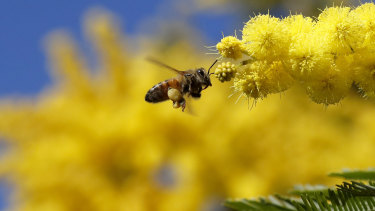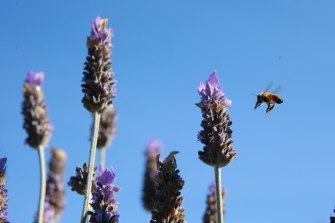It’s been a bad few years to be a bee. Last summer was full of drought and fires; this summer was a damp squib, with rain washing out foraging expeditions and rinsing nectar and pollen off flowers.
Beekeeper Elke Haege Thorvaldson, whose honey bees roam close to Centennial Park, says it’s been the toughest period her bees have experienced in a decade of beekeeping. And with winter upon us, bees – both honey bees and our local native bees – need some help from gardeners.
Honey bees have had a hard time of late.Credit:AP
Cold weather changes bee behaviour. Native bees stay snug unless the temperature gets to 18 degrees, but on sunny winter days they come out to forage. If necessary, they will venture up to 500 metres from home in search of food, but flying uses lots of energy so close sources of sustenance are preferred.
While honey bees remain active through winter, as long as the weather isn’t too cold or wet, they start work later in the day and finish earlier. Honey bee workers can travel up to five kilometres in search of food, but – just as for their much smaller bee-brethren – closer is better.
Thorvaldson says that the best thing gardeners can do to help their local bees is to plant lots of flowering plants. Like humans, bees thrive on a diet of diversity so aim to provide four different species in flower at any one time.
Even in winter lavender attracts bees.Credit:Fairfax
If possible, make one of them blue-ish. Bees seem to have a preference for blue and purple flowers. Their photoreceptors are sensitive to ultraviolet, green and blue wavelengths. Researchers have found that where tough environments reduce the number of pollinators, putting reproductive pressure on plants, there is a greater than expected number of blue flowers.
Blue flowers for winter include rosemary; French and Spanish lavender, which both do better in places like Sydney than English varieties; and Salvia ‘Mystic Spires Blue’, which flowers all year and gets to about a metre tall and wide. Prune to shape and to renew vigour in spring.
More mauve than strictly blue, the flowers of the native Westringia ‘Blue Moon’ are attractive to bees. On the purple side of blue is the native climber hardenbergia. It also comes in a white form, ‘Snow White’, whose delicate panicles of pea flowers look especially good against the vine’s dark green leathery leaves.
For more winter whites, try Lobularia ‘Snow Princess’, a perennial form of the annual alyssum, which flowers year-round with honey-scented blooms.
Increase the diversity by encouraging some wildness: allow a few herbs and vegetables to go to flower, and let clover and the odd dandelion blossom in the lawn. The bees won’t judge.
GREATER GOOD
In need of some good news? The Greater Good newsletter delivers stories to your inbox to brighten your outlook. Sign up here.
Most Viewed in Lifestyle
From our partners
Source: Read Full Article


